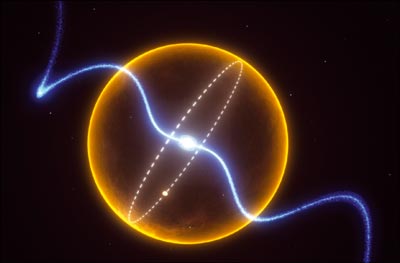
Image credit: Swinburne Astronomy Productions, Swinburne University of Technology.
“Remember when you were young, you shone like the Sun”, opens the famous song Shine On You Crazy Diamond. Written as a tribute to Syd Barrett, Pink Floyd’s lead musician until 1975, it could also refer to a newly discovered planet orbiting a pulsar. The planet was once a star but the pulsar robbed it of almost everything except for its innermost part of crystalline carbon (diamond) and oxygen.
The supernova explosion of massive stars usually leaves behind an ultradense neutron star formed by the collapse of the iron core of the former star. Like a giant atomic nucleus, neutron stars typically contain the mass of the Sun in a sphere of about only 10 km in radius. They often manifest themselves as pulsating stars, or “pulsars”. The observed pulsation comes from the spin of the neutron star shining a beam of radiation from a magnetic pole towards the Earth at each rotation (CERN Courier September 2006 p13). The pulse duration corresponds to the spin period of the neutron star and ranges from about 1 ms to 10 s. Millisecond pulsars – the most rapidly rotating – are thought to have been spun-up via accretion of matter from a companion star (CERN Courier December 2010 p10). That about 30% are solitary suggests that some might have completely “eaten-up” their companion star, either via continuous accretion or by the merger of the binary system.
While extrasolar planets are continuously being discovered around normal stars (CERN Courier November 2010 p13), planets around pulsars are extremely rare. So far, an extrasolar planetary system has been found around only one pulsar, PSR B1257+12. It comprises two planets of about three times the mass of the Earth and a third body of lunar mass. The origin of these first detected exoplanets – back in 1992 – is still puzzling astronomers. Could the planets have survived the supernova explosion at the origin of the pulsar or did they form afterwards out of a remaining disc of matter?
The presence of an orbiting companion can be detected by a sinusoidal modulation of the arrival times of the pulses. Such a characteristic signal has now been detected among almost 200 TB of data processed by supercomputers as part of a systematic search for pulsars. The modulation observed by the 64 m radio telescope in Parkes, Australia, suggests the presence of a Jupiter-mass planet orbiting the newly discovered pulsar PSR J1719-1438. The period of the orbit is only 2.2 hours, corresponding to a distance between the planet and the pulsar of no more than the radius of the Sun.
This tight orbit gives strong constraints on the size of the planet. It must be much denser and hence smaller than Jupiter to prevent it from being ripped apart by the strong gravity of the neutron star. A minimal density of 23 g cm–3 was calculated by a team led by Matthew Bailes, of Swinburne University of Technology in Australia, together with colleagues from Europe, Australia and the US. This exceeds the density of any chemical element and suggests that the planet-like body is made of matter in extreme conditions similar to those found in white dwarfs.
Low-mass white dwarfs have already been found around millisecond pulsars, but this one is unique as it would have lost more than 99.9% of its original mass to the hungry pulsar. The remnant planet-mass body is most likely to be made mainly of carbon and oxygen and the density is such that it is certain to be crystalline, which means that a large part of the star may be similar to a diamond. To check how brilliant and transparent the planet really looks, one would have to travel 4000 light-years towards the constellation of Serpens.









6 Comments